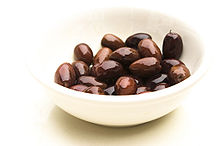Our website is made possible by displaying online advertisements to our visitors.
Please consider supporting us by disabling your ad blocker.
Kalamata olive
| Kalamata | |
|---|---|
 A bowl of Kalamata olives | |
| Olive (Olea europaea) | |
| Color of the ripe fruit | Dark purple |
| Origin | Greece |
| Notable regions | Kalamata |
| Hazards | Verticillium wilt and cold |
| Use | Table and oil |
| Oil content | 6 |
| Symmetry | Slightly asymmetrical |
| Nutritional value per 100 g (3.5 oz) | |||||
|---|---|---|---|---|---|
| Energy | 284 kJ (68 kcal) | ||||
3g | |||||
6.8g | |||||
0g | |||||
| |||||
Source:[1] | |||||
| †Percentages estimated using US recommendations for adults,[2] except for potassium, which is estimated based on expert recommendation from the National Academies.[3] | |||||
The Kalamata olive is a large, dark purple olive with a smooth, meaty texture, named after the city of Kalamata in the southern Peloponnese, Greece.[4][failed verification] Often used as table olives, they are usually preserved in wine vinegar or olive oil. Typically the term "Kalamata" legally refers to a region of Greece where these olives are grown, but a few countries (mainly outside the United States and European Union) use the name for such olives grown anywhere, even outside of Greece. Within the EU (and other countries that ratified PDO agreements or similar laws), the name is protected with PDO status, which means that the name can only be used for olives (and olive oil) from the region around Kalamata.[5] Olives of the same variety grown elsewhere are marketed as Kalamon olives in the EU and, sometimes, elsewhere.[6][7][8][9][10]
- ^ "Kalamata Olives". Livestrong.com. Archived from the original on 6 February 2014. Retrieved 21 May 2011.
- ^ United States Food and Drug Administration (2024). "Daily Value on the Nutrition and Supplement Facts Labels". FDA. Archived from the original on 2024-03-27. Retrieved 2024-03-28.
- ^ National Academies of Sciences, Engineering, and Medicine; Health and Medicine Division; Food and Nutrition Board; Committee to Review the Dietary Reference Intakes for Sodium and Potassium (2019). "Chapter 4: Potassium: Dietary Reference Intakes for Adequacy". In Oria, Maria; Harrison, Meghan; Stallings, Virginia A. (eds.). Dietary Reference Intakes for Sodium and Potassium. The National Academies Collection: Reports funded by National Institutes of Health. Washington, DC: National Academies Press (US). pp. 120–121. doi:10.17226/25353. ISBN 978-0-309-48834-1. PMID 30844154. Retrieved 2024-12-05.
- ^ Miller, Korina (2010). Greece. Oakland, California: Lonely Planet. p. 218. ISBN 978-1-74179-228-7.
Kalamata olive.
- ^ Quinn, Jennifer (29 July 2004). "Selling porkies - an almighty pie fight". BBC News Online Magazine. Retrieved 21 May 2011.
- ^ "Kalamon and Kalamata Olives – legislation changes the name". Archived from the original on 2014-05-19.
- ^ "On the different varieties of Greek olives".
- ^ "What is the difference between Kalamon olives and Kalamata olives?". Archived from the original on 2017-10-01. Retrieved 2016-05-01.
- ^ "Greek Olive Species".
- ^ "Olive Cultivars of South Africa". Archived from the original on 2018-09-24. Retrieved 2016-05-01.
Previous Page Next Page


